Welcome guitar effects pedals enthusiast!
You still don’t have a good octave pedal in your effects chain? Shame on you! (Just kidding).
You need to have one of those in your dream pedalboard. But before buying one online, you need to know some things about them. And that’s why I’m here, to help you avoid having to research the whole internet.
Below you will find my selection of the Best Octave Pedals on the market. It will help you find the right one to sound like a champ in the studio or on stage.
Quick Overview
Our Top 3 Choices For Best Octave Pedals
Boss OC 3 Dual Super Octave
The Boss OC-3 is an old-school ultra-efficient one. It’s certainly one of the best octave pedals and a great addition to your gear.
Electro Harmonix Micro Pog Polyphonic Octave
The Micro POG is one of the best octave pedals in the market. It has a single input and two outs to let you split the dry and wet signals. It works by generating two separate signals, the first is one octave lower than your original guitar signal, and the second is one higher.
Donner Digital Harmonic Square Octave Pedal
The Donner combines a pitch shifter with octave effects. Between its features and functionalities, there are various modes to select, wet and dry signals, true bypass, etc.
The 5 Best Octave Pedals to Complete Your Signal Chain!
#1. Boss OC 3 Dual Super Octave
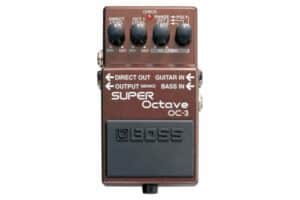
When you need an octave pedal that does a good job adding texture and depth to your sound, the Boss OC-3 is an old-school ultra-efficient one. It’s certainly one of the best octave pedals and a great addition to your gear.
If you play bass, consider this pedal because the OC 3 has an input for both guitars and bass and a direct out and singular mono output. So you need not buy another octave pedal for your bass like an MXR M288 Bass Octave Deluxe.
As the world’s first polyphonic octave generator, the OC-3 offers three modes of octave effects, and an adjustable poly octave effects drive setting. The OC-3 has received several praises from contests worldwide due to bringing these features.
Before the OC-3 pedal, an octave guitar effect pedal could be used only for single notes. As a polyphonic octave generator pedal, the OC-3 can be used when playing a chord. The polyphonic effect can emit a full chord modulated signal because it can split notes and harmonize across multiple strings.
The OC-3 is a very customizable Octave pedal thanks to its Four Knobs. Let’s see now what kind of magic you can do with them:
- Direct Level: With this knob, you control the octave effect’s direct input to add to your signal with this pedal.
- Oct 1 Level: this one modifies the pedal’s basic octave signal, which we can see as the octave output depth.
- Octave 2: This knob, with the Poly knob’s 3 modes, controls the effect blended with the other controls on the pedal.
- Poly: This control has 3 modes and allows you to select the octave effect’s note ranges for your pedal. Mode 1 is your overdrive gain level. Mode 2 is the level of the second octave. And Mode 3 is the active “range” of the effect.
Let’s see now what you can do with every one of the Boss OC-3 Super Octave modes:
- Drive Mode: This mode kicks the signal into a fuzz-like effect converting the OC-3 into something very similar to a fuzz pedal. It adds additional distortion/overdrive to the Octave 1 signal (one octave below). You can adjust the Direct Level knob and the Oct 1 Level knob to blend the two signals in the pedal in the way you want.
- Oc-2 Mode: This mode functions as a BOSS OC-2 pedal emulation. You have three signals in this mode—the original instrument tone, one octave, and two octaves below. You get individual level controls with the three signals to customize the effect’s overall character. This mode does not have a distortion/overdrive effect because this functions only as a classic effect emulation.
- Poly mode: the Poly Mode on the Boss OC3 pedal functions only on lower notes, so you can set it up to only add an octave to the lowest two or three strings, leaving your higher strings signal clear.
You’ll love this:
- Separated outputs: You can sum the direct and the effect signal into one output thanks to the separated Direct Out and Output (Mono).
- Bass or guitar: the Boss OC-3 Super Octave pedal is a very flexible pedal that works with electric bass or guitar.
- More flexibility: It is recommended to use both outputs of the pedal to get more flexibility on how you want to shape the sound.
You might not like this:
- Too fuzzy drive mode: The drive setting may be a little too fuzzy or heavy for some tastes.
PROS
- It’s an easy to use, high-quality octave pedal for all guitarists.
- Both guitar and bass sound equally great through this pedal.
- You can get cool effects working with the dry and wet signal as if they were two instruments.
CONS
- The drive effect is not the standard drive effect you are used to.
- It can become sensitive with down-tuned guitars.
#2. Electro Harmonix Micro Pog Polyphonic Octave
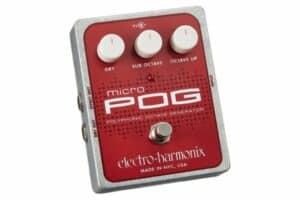
The Micro POG is a high-quality option for those guitarists who want a reliable and straightforward octave generator. It is a Sub n Up Octaver pedal, so it delivers an octave below and above a given note. All three sounds can be balanced with the controls.
The Micro POG is one of the best octave pedals in the market. It has a single input and two outs to let you split the dry and wet signals. It works by generating two separate signals, the first is one octave lower than your original guitar signal, and the second is one higher.
Its perfect polyphonic tracking and musical flexibility made the classic original EHX POG legendary. The EHX Micro POG has a simplified design in a small pedalboard-friendly chassis, but it delivers the same perfect tracking and consistent polyphony.
Below I listed the most important benefits offered by the Micro POG:
- Polyphonic: Like any good pitch-shifter pedal, it is essential to be polyphonic. The Micro POG was designed this way so you can work with more than one note at a time. You can find octave pedals out there only designed for monophonic playing, and you will hear glitches when you play chords or arpeggios.
- Each signal has a separate control: With the Micro POG, you count with three main knobs to give you complete control over the mix. The DRY knob controls the level of the dry tone. The SUB OCTAVE controls the level of the tone one octave lower and the OCTAVE UP one higher.
- DRY OUT / EFFECT OUT: the Micro POG gives you two different outputs. The DRY OUT always delivers your dry tone even when the pedal is activated, and the EFFECT OUT sends out the effect. This way, you can send this dry signal to a separate amp or effects chain without affecting your main rig.
The Micro POG is a very musical octave pedal with almost none of that disturbing jiggle on lower notes and chords. It can transform your guitar into a 12-string one, into a church organ, or even into a competent bass.
The Micro POG is very similar to the original POG but in a digital version. One important thing about the new Micro POG is that it is more accurate than the original.
You’ll love this:
- Simple to use octave pedal: EHX made an octave pedal that is incredibly easy to use. By adjusting the three simple level knobs, you will obtain the different effects you’re searching for. Just that simple!
- 12 string guitar effect: An original 12 string guitar doubles each string with a second-string an octave higher, except the high E and B strings. The Micro POG makes your guitar sound like a 12 string by adding a signal an octave higher into the mix.
- Bass guitar effect: By simply turning the DRY and OCTAVE UP knobs all the way down and turning the SUB OCTAVE knob all the way up, you will simulate a bass guitar. With this method, The White Stripes perform the main riff of “Seven Nation Army.”
You might not like this:
- Slightly high price: The Micro POG can seem a little more expensive than the rest of the range.
PROS
- It’s a totally stable and compact octave pedal.
- It has it all, from 12-string sounds, pseudo organ sounds, and much more.
- The three simple pots version is much simpler than the original POG.
CONS
- It can demand time to get used to.
#3. Donner Digital Harmonic Square Octave Pedal
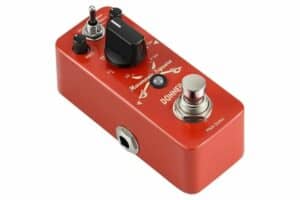
If you are searching for an affordable, compact, and high-quality pitch shifter/octave pedal, the Donner Digital Octave Guitar Effect Pedal Harmonic Square is the best option to satisfy your needs.
It is extra versatile, and you can use it with your standard 6 string electric guitar or your 4 string bass guitar. But it works nicely also with Yamaha keyboard, vocals/mic, etc.
The Donner combines a pitch shifter with octave effects. Between its features and functionalities, there are various modes to select, wet and dry signals, true bypass, etc.
This tiny pedal counts with 3 knobs, a toggle switch, and a footswitch. These controls will let you modify all the Donner’s parameters:
- The Wet and Dry Control knobs control the harmonic and dry signal volume.
- The three-way toggle switch allows selecting between Sharp, Detune & Flat modes in this pedal. The wet and dry knobs settings will determine how sharp your tone is compared to the natural one once you have selected one of these modes.
- The big dial knob in the center controls the signal by 2, 3, 4, 5, 7, 12, and 24 semitones.
You’ll love this:
- 7 modes to select from: These 7-octave modes include ±2, ±3, ±4, ±5, ±7, one and two octaves. By these modes, the Donner Digital Octave is also called Harmonic Square 7 modes.
- Control Wet and Dry signals: The Donner can control the harmonic signal level, called the wet or synthesized signal and the dry signal that is the original input signal from the guitar.
- A small and lightweight enclosure: With only 2.36 x 2.44 x 3.94 inches and less than 9 ounces, the Donner can fit everywhere, and it is also very portable. Besides, its Aluminium alloy enclosure makes it ultra-stable and rugged.
- True Bypass: Pressing the true bypass footswitch can activate or deactivate this effect unit.
You might not like this:
- The Donner pedal small-sized enclosure’s negative side works only with a Dc 9V power supply and doesn’t admit 9V batteries.
PROS
- The minimal number of knobs enhance playability.
- It is an incredibly flexible and versatile octave pedal.
- It has a low noise level.
CONS
- The sound can be synthetic.
#4. Electro-Harmonix Pitch Fork
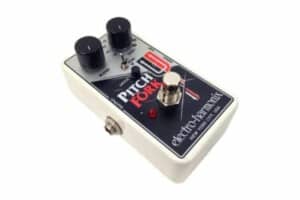
The Pitch Fork seems to be the perfect option for those exigent guitarists in a quest for a high-quality polyphonic pitch shifter and harmony pedal that offers all the complete package.
The Electro Harmonix Pitch Fork delivers up to three complete octaves. Adding a selection of closer intervals to be set above and below the dry note. EHX achieved to join all its pitch-shifting knowhow into this Forky tinny box.
The Pitch Fork allows you to double your shifts with dual harmonies, and you can add a compatible expression pedal. It includes POG’s features like one octave up, one octave down, and the tasty detuned chorus modes.
The Pitch Fork is a very customizable Octave pedal:
- Adjusting the Shift 11-way rotary pitch control, you can select between D (Detune), Minor 2nd, Major 2nd, Major 3rd, Perfect 4th, Perfect 5th, Major 6th, Minor 7th, 1 Octave, 2 Octaves, and 3 Octaves.
- The blend knob balances the shifted sound with your clean signal.
- Meanwhile, the little toggle switch in the middle adjusts between up, down, and dual shifts.
- EXP jack lets you control pitch and glissando with an expression pedal.
- The Latch button lets you select between Latch or Momentary mode. This affects how the footswitch and EXP input behave.
In Latch mode, the footswitch toggles between effect on and buffered bypass each time it’s pressed, and the EXP input continuously varies pitch. In Momentary mode, the effect is only on while the footswitch is pressed down and the Pitch Fork goes into bypass when it’s released.
You’ll love this:
- Accurate intervals: Of course, you need your instrument to be perfectly in tune before you start playing with the Pitch Fork. But when you achieved that, the intervals delivered by this tiny case are ultra-accurate.
- Noise-free: Intrusive noise is minimized, and string curves are authentically duplicated.
- Tonal potential: EHX has made a great work because the Pitch Fork’s tonal potential is overwhelming.
- Expression pedal: You can add one to customize your octaved sound.
You might not like this:
- More latency: the Pitch Fork can experience a little more latency than a DigiTech Drop or Whammy, and a touch more hisses, too.
PROS
- Tracking accuracy and excellent overall tonality of the shifts.
- Plenty of modes to experiment with.
- Expression pedal compatible.
- Dual harmonies.
CONS
- A bit more hiss and latency than with a Whammy pedal.
#5. DigiTech Whammy (5th Gen)
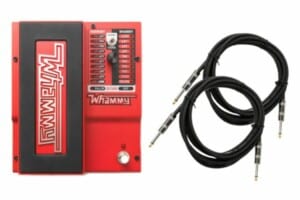
We can say that the DigiTech Whammy is instantly recognizable. This fifth-generation Whammy has impressive pitch-shifting capabilities.
It has gone through several build changes since its origin with the highly regarded WH-1, the pedal that started it all. The newest Whammy is closer in terms of look and size to the original than the fourth-generation model.
The fifth-generation Whammy brings these pedal features:
- MIDI input for controlling the Whammy’s effects with an external controller.
- The pedal’s pitch-shifting algorithms have been updated for a smoother response.
- Four additional Whammy modes are taken from the Whammy DT pedal.
- A polyphonic pitch-shifting mode.
- True-bypass switching.
- 9V DC power-supply operation has been added, too.
The Whammy V pitches perfectly because, in this new version, the octave effect remains slick and very precise. The harmony modes give up a mixture of dual signal lead possibilities and dissonant textures.
This fifth-generation Whammy handles simple and complex chords with ease in the polyphonic mode. DigiTech added the Whammy DT’s 5th and 4th interval-up and 2nd, 4th, and 5th interval-down modes to the pitch-shift menu.
You’ll love this:
- Sometimes, the fifth parts are the best: This Whammy version accurately duplicates the original Whammy’s qualities while adding new features and effects.
- Many updates from former models: The Whammy V seems to be the best of all Whammys with the addition of true bypass, a slightly smaller and more comfortable footprint.
- Polyphonic: The new Whammy is polyphonic, allowing you to pitch, bend, and harmonize full chords with no glitching.
You might not like this:
- Digital groans: You can hear digital cries in the harmony mode.
PROS
- Silky-smooth pitch shifting.
- Long overdue true-bypass switching.
- The perfect pedal to push the limits of your playing.
CONS
- Quick playing in its polyphonic mode can cause the pedal to fail.
Most Asked Questions About Octave Pedals
What do octave pedals do?
Guitar octave pedals provide tones that are octaves above or below the frequency of the guitar being played. These are used to synthesize notes or chords and pitch them one or several octaves higher or lower from the current played note or chord.
When you use an octave pedal, this monitors the guitar’s signal to create a frequency output. The original signal and modified signal are then mixed and sent to the output so you can hear the desired sounding octave effect.
These octave pedals can be used alongside other guitar effects pedals. They are good to obtain a funky guitar shedding sound. Jimi Hendrix was a pioneer in using an octave pedal to deploy the octave effect in his record and performances.
Adding higher octaves can generate a sizzling effect, while lower octaves will fatten up the guitar’s sound and make it sound like a bass. Several Octave pedals on the market can vary in their octave range. They can be monophonic or polyphonic and can be digital or analog octave pedals.
Where should an octave pedal go?
Adding an octave pedal to any signal chain allows a creative and exciting range of sounds. But when the time comes to connect this interesting effect pedal, you may wonder where an octave pedal should go?
It will always be better to put an octave pedal at the beginning of the effects chain. The ideal position is before the drive/distortion section but after the tuner and volume pedal. This position in your signal chain will ensure you a clean signal when the effect is activated.
Can an octave pedal damage an amp?
It is almost impossible for an octave pedal to damage your amp. But it can hurt your speakers because amp speakers are not designed to handle low frequencies.
Octave pedals can allow your guitar to sound like a real bass. When using this effect, the pedal generates low frequencies. And there exists the chance you can damage your amp’s speakers.
What is octave fuzz?
To add some fuzz to your octaved signal, you will need an Octave Fuzz pedal. These octave pedals provide fuzz mixed with the octave effect to the input signal’s frequency.
These octave pedals can generate different accompanying frequencies:
- The first of 12 semitones (1 octave) above is called an ‘upper octave fuzz.
- The second of 12 semitones (1 octave) below is called a ‘sub-octave fuzz.’
Besides the fuzz effect, there is usually a gain knob to raise or lower this fuzz’s intensity, independently of the main signal’s fuzz tone.
Top Picks
It has come the time when I reveal my Top Picks. This way, I want to make choosing The Best Octave Pedal easier for you. I really like this segment of the article.
Let’s discover my Top Picks!
3rd Place: Donner Digital Harmonic Square Octave Pedal
Donner Digital Harmonic Square
The Donner Digital Harmonic Square Octave Pedal is a versatile, compact, and durable pitch shifter/octave pedal.
It counts with three knobs to control the harmonic and dry signal volume, selecting between Sharp, Detune & Flat modes and controlling the signal by 2, 3, 4, 5, 7, 12, and 24 semitones.
It has a small and lightweight enclosure to fit everywhere, it is very portable and has an ultra-stable and rugged Aluminium alloy enclosure.
So, I name the Donner Digital Harmonic Square Octave Pedal my Second Runner-up.
2nd Place: Electro Harmonix Micro Pog Polyphonic Octave
Electro Harmonix Micro Pog Polyphonic Octave
The Electro Harmonix Micro Pog is a reliable and straightforward octave generator. It allows mixing and balancing all three sounds: an octave below, an octave above, and the original signal.
It has perfect polyphonic tracking, a simplified design in a small pedalboard-friendly chassis as the original EHX POG but delivering the same perfect, consistent polyphony.
The Micro POG can work with more than one note at a time. It counts with three main knobs to give you complete control over the mix. It can deliver 12-string sounds, pseudo organ sounds, and a stable and compact octave pedal.
This is why I name the Electro Harmonix Micro Pog as my Runner-up.
Winner: Boss OC 3 Dual Super Octave
Boss OC 3 Dual Super Octave
The Boss OC 3 can add texture and depth to your sound. It has an input for both guitars and bass along with a direct out and singular mono output. The OC-3 is a polyphonic octave pedal; it has 4 Knobs and offers 3 modes of octave effects.
The OC-3 polyphonic effect can emit a full chord modulated signal because it can split notes and harmonize across multiple strings. Thanks to its Drive Mode, you can kick the signal into a fuzz-like effect. It adds one octave below the drive signal to the original signal.
It has a mode to function as a BOSS OC-2 Emulation, so you have three signals—the original tone and two separate octaves below. You can set the Poly Mode up to only add an octave to the lowest two or three strings, leaving your higher strings signal clear.
Thanks to all these benefits, I want to name Boss OC 3 as The Winner!
Conclusion
Octave pedals are great for generating a cool effect by adding higher octaves or making your guitar sound like a bass by adding lower octaves.
Here, you have learned the most important benefits and features of the best octave pedals available in the actual market. Now, you know the different ranges that everyone covers: monophonic, polyphonic, analog, or digital octave pedals.
I tried to show you what I believe are the most trustworthy available models. Now you have adequate information to judge yourself which one is the best option to better fit your needs.
I hope this article helps you learn how to harmonize your tune with these effects pedals and that you discover which one is the Best Octave Pedal for you.


